Devoe in d'Air
![]()
Devoe in d'Air |
|
by Colonel John Brooks Devoe
|
This appeared in the September 1995 issue of the Falco Builders Letter. |
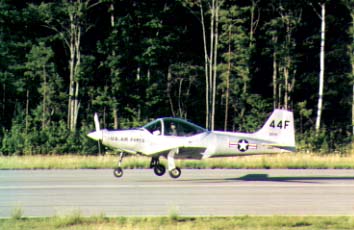
The 22nd of June 1995 dawned clear and bright at 6B1 (Skyhaven Airport, Rochester, NH) and as I drove across the tarmac to my hangar, I noted the wind sock hung limp. Excuses for not doing it were exhausted; CAVU weather and a ready Falco. As a matter of fact, both the weather and the Falco had been conducive to flight since the 20th, flight plan prepared, tanks each half full, tow bar in place... but I remembered the words of our now departed friend, Karl Hansen, "John, once it is ready, take a few days off". I did that-cut the grass, weeded a few gardens, sat on the deck. Now I am ready.
I tried, unsuccessfully, to saunter into the FBO Airport Manager's office to advise him of my intentions. Although the sock was virtually limp, the indicator favored runway 15, not my choice for two reasons. First, it meant climbing into the sun (Army Air Corps tradition not withstanding, after cataract surgery, not the way to go on a first flight), and second, my flight time in a Falco had been using runway 33 and familiar landmarks had been noted. Make it easy for yourself. I mentioned my preference to FBO Terk Williams and without hesitation he picked up the mike and announced "Skyhaven traffic, the active runway is now 33, we have an experimental aircraft, Falco 644F, about to take off on its first flight." Terk now has a fuel customer for sure.
Preparation is everything, for the pilot as well as the machine. I had expected to fly the Falco last autumn and hence some ten months or so ago I chose mentors Karl and Tony Bingelis for guidance. We three shared a common background-aviation cadets, WWII, Army Air Corps, USAF, Falco builders, and we spoke a common language. Of no less significance was the generosity of another Falco friend (we have many, do we not?), Bob Bready, who gave most willingly of his time and wind machine by flying into 6B1 on three different occasions to give me both air time and some ten landings in the left seat. He said if I broke his, he would take mine. I have mine, he has his. Thanks, Bob.
The machine preparation really begins the day you first put glue to Sitka spruce. Establish a consistent standard in everything you do. My tolerance limit was one half millimeter, trying for those "31.327" was beyond my patience. Assemble no "that's good enough" solutions in construction, for as they accumulate, they will haunt you. If it's not right, take it apart and do it over. Nothing but the knowledge that you have done it right will give you more confidence in your machine on that first take-off roll.
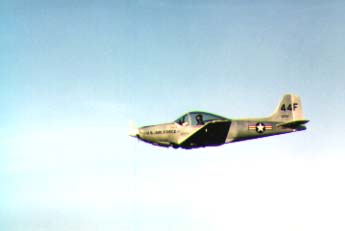
The final preparation of the Falco after assembly is best done with the aid of the extensive and most comprehensive checklist provided by Sequoia. I followed it and had a friend, Tony Petrulio, repeat it. Tony had first come on my Falco scene a few years back, but in the past year has put many hours into the finishing process, from sanding to polishing to assembly ("where was he when I needed him?"-Bob Bready). Tony got into aviation through a route rather different than mine. He says he was eliminated from aviation cadets for flying the down-wind in a T33 inverted. They said it was attitude, he said the blue was in the right place when he did it. He went on to fly cucumbers out of Cuba in B17s, flew air taxi, ferried new and derelict aircraft from coast to coast, was personal pilot to a number of prominent entertainers and finally got a respectable job as captain for US Air. Tony is now retired and since N644F is now completed, he was concerned about unemployment.
Have no fear, to rectify that and preclude withdrawal pains, his wife, Karen, gave him a set of Falco plans for his sixtieth birthday. He is now one of us, frustrations, joys and Falco friendships included.
Other inspectors were Bob Bready and that Italian baker turned artist, James Michael DeAngelo. I also asked non-Falco builders to look-lots of eyes. The airworthiness inspection went off without a gig. The inspector was impressed with the airplane, the first Falco he had seen.
On the advice of Karl, Tony B. and Bob I limited the invited guests: my wife, Gwen, Tony P. and his wife and a young pilot who had just soloed on his 16th birthday in May. He allowed as how he had a video camera and would I like to have him record my first flight? Tony Bengalis had said that the first landing will be the best you'll ever make in your Falco, thus I thought to have a record of it!
The pre-flight was done with deliberate care, Tony P. following me about. Gwen waved as the IO-320-B1A came to life and "four four fox" started its 3000' taxi to the active, the trip giving me time to remember a few more words from Tony B... "you'll be a bit nervous as you taxi to the runway and do the run-up, but once you pour the coal to it, you'll just become a pilot on take-off." It was true, the run-up was just fine, and I remembered to close the canopy.
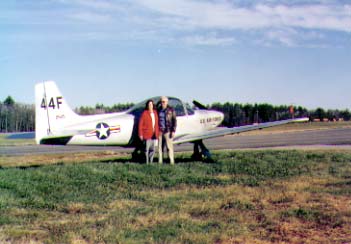
Gwen and John Devoe
Very light forward pressure on the stick (keep the nosewheel on the runway until you hit 65 KIAS, Bob B.) until I read 65, pressure relaxed, it flew! I let the speed pick up to 90 KIAS, noted 2750 on the tach, grossly fluctuating manifold pressure, #4 CHT approaching the red line. Fly the airplane. I pulled the prop control back a tad, ignored the M.P/ gauge and the high CHT, but lowered the nose for 100 KIAS. I climbed to 2500' and stayed over the field. At altitude I brought it back to 25/25, performed the cruise check list and looked around. This is great! The wings are still on, the engine is turning over strong and willing and the star and bars has not peeled off of the left wing. No heavy wing at take-off and now in cruise hands and a bit of forward trim, the wings remain level. With no rudder input to compensate for the high power setting the ball is just a bit off center. Airspeed is a bit above gear down speed but I am told not to worry should that be so. Since Bob B. had neglected to leave me his handheld (I neglected to ask) I stared in touch with the FBO reporting my minor problems, condition and position. It made me feel less alone to have some chatter, but the Falco is a joy to fly solo.
I reflected briefly on those on the ground, anxious? Gwen later declared not to have been but on the video tape she is heard to say to Tony P. "It looks great and the engine sounds good...[pause] doesn't it?" Tony assured her that was the case. A weather balloon ascended, noted by my witnesses. Tony, confident of my skills (?) said "golly, I hope John doesn't hit it."
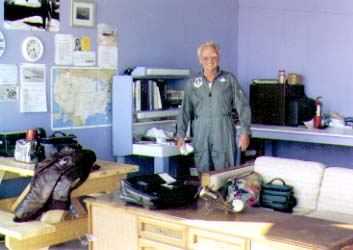
One happy builder.
I had tried to keep the banks moderate, as little as ten degrees, but the Falco doesn't like that apparently for they were nearer to twenty/twenty-five. Seemed natural and the machine behaved. I had read a lot about first flights and resolved to use the KIS (keep it simple) approach. I did no stalls nor approaches to stalls, but used a technique suggested by Bob Bready. The gear is down. slow the aircraft (flaps up) to first 90, then 80 and then 70 KIAS. Plenty of control? If so you can achieve that goal of a safe landing, for with 20 or more degrees of flap you'll have even more control for the pattern. I used 90 on the final, 80 on the flare making no attempt to hit the numbers, waiting it out and touching down on the 1000' marker on a 4000' runway. Thirty degrees of flap. make it easy for yourself. In more recent flights I have slowed those final approach speeds somewhat.
The engine, my most primary concern, performed flawlessly. A few days before the flight I had called the engine builder, Don George suggesting I was depending on the quality of his work. He, in his customary formal manner replied "Colonel Devoe, just give my engine the fuel it needs and it will take you wherever you want to go." It did and I am confident it will. When I reported the high CHT to him after the flight he did not seem overly concerned, and said it would come down.
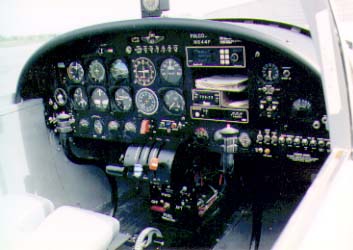
Only round gauges in this 'military' bird.
I borrowed a known-to-be-good M.P. gauge from the FBO, bought a new one and replaced the original in short order. The 2750 RPM problem was corrected by taking a few turns on the prop governor adjustment screw. The CHT on #4 still is a bit high (#3, 2 and 1 are better). Jim DeAngelo is of the opinion that the mineral oils used for break-in do not cool as well as regular oils. Others I have talked to share this belief.
The landing was indeed a kisser, and I have the tape to prove it. Tony B. was right, I haven't had its equal... perhaps soon. Champagne in the hangar for our small audience completed the day at the airfield. I went home and took a nap.
The "Lady G" (a carefully selected name to honor my late wife, Genevieve, and my present bride) will soon fly off its 25 hours (Airstream vacations in the summer not withstanding). The basement is empty and filled with construction memories, the hangar filled with Falco and expectations. The over-ten-year experience, the frustrations, joys and friendships have been worth it. I know I shall never go to a fly-in, observe a homebuilt of different roots, and say, "I wish I had built that one". Thank you, Mr. Frati, and thank you, Alfred.
I also thank Falco builders for the willingness to provide any sort of help I needed or thought I needed. In the early stages it was Jim DeAngelo, middle stages Steve Wilkinson and in the latter stages, Bob Bready and Tony Bingelis. At times I am sure I tried their patience. I now stand willing to help those who come after us. And thank you, Gwen, for your willingness to support an old man's dream.
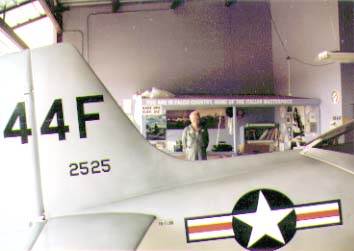
|
|